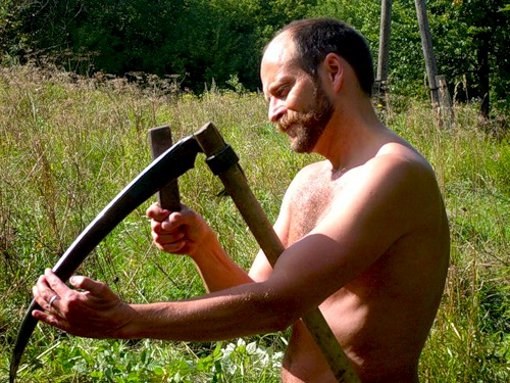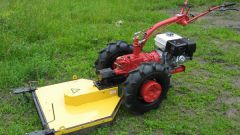Preparation of a braid consists of two operations of pressing and turning.
To sharpen a scythe, you need:
- negativo "grandma" (the anvil);
- hammer of high quality steel, subjected to tempering process;
- a whetstone (made of a fine-grained emery).
Before you start weaning, it is necessary to find a suitable log or stump (with a length of 25-30 cm, 40-50 cm) to score in his butt bounce "grandmother" (it is necessary to have the farm). It is a metal (small anvil, one end of which is made in the form of a "head" with the platform, and the other cone is pointed. At a distance of about 1 m from the log you must create a support for cocovia, which you need to stick in the ground the stick in a slingshot (or connected between the cross sticks).
Padding must be performed sitting on a small (low) chair or stool. Braid should be put so that its blade lay on the bottom side of the "grandmother", the shaft must lean on the cross sticks. Padding is necessary to begin from the "heel" of the tool which the blows of the hammer must produce a thinning of the blade edge (width of about 2.5-3 mm).
PEEN hammer, you should try to position at a slight angle to the blade. Contact with the scythe should only part of the striker. While attacking you need to move the blade on the anvil. The refinement should be brought to a high degree, but not to prevent cracking and bending of the spit.
Thus, all the blade will become thinner, with the exception of its tip (about 1 cm). During weaning, the braids should be very careful, it is necessary to constantly monitor the adherence of the blade to "grandmother". The hammer blows should be applied evenly. Work can be done in a home workshop.
To sharpen a scythe, you need to stick the end of the pole into the ground or into something to Balk, skip the upper part of cocovia under the left arm (in the shoulder), press it to the torso. The end of the scythe blades need to point it toward the ground. The fingers of his left hand to put on the back side of the blade, closer to its end, and they need a shoulder to securely lock the tool.
Right hand to take the touchstone (for the third part of its length) repeatedly to move from "heel" to the end (running alternately that with one, on the other side of the blade), to sharpen a scythe. This will require at least 15-20 of these movements. The tool is well polished and on a regular sanding disc, but the best result of the refinement of her blade is achieved in the case described above.
To sharpen a scythe, you need:
- negativo "grandma" (the anvil);
- hammer of high quality steel, subjected to tempering process;
- a whetstone (made of a fine-grained emery).
Weaning braids
Before you start weaning, it is necessary to find a suitable log or stump (with a length of 25-30 cm, 40-50 cm) to score in his butt bounce "grandmother" (it is necessary to have the farm). It is a metal (small anvil, one end of which is made in the form of a "head" with the platform, and the other cone is pointed. At a distance of about 1 m from the log you must create a support for cocovia, which you need to stick in the ground the stick in a slingshot (or connected between the cross sticks).
Padding must be performed sitting on a small (low) chair or stool. Braid should be put so that its blade lay on the bottom side of the "grandmother", the shaft must lean on the cross sticks. Padding is necessary to begin from the "heel" of the tool which the blows of the hammer must produce a thinning of the blade edge (width of about 2.5-3 mm).
PEEN hammer, you should try to position at a slight angle to the blade. Contact with the scythe should only part of the striker. While attacking you need to move the blade on the anvil. The refinement should be brought to a high degree, but not to prevent cracking and bending of the spit.
Thus, all the blade will become thinner, with the exception of its tip (about 1 cm). During weaning, the braids should be very careful, it is necessary to constantly monitor the adherence of the blade to "grandmother". The hammer blows should be applied evenly. Work can be done in a home workshop.
Turning the spit
To sharpen a scythe, you need to stick the end of the pole into the ground or into something to Balk, skip the upper part of cocovia under the left arm (in the shoulder), press it to the torso. The end of the scythe blades need to point it toward the ground. The fingers of his left hand to put on the back side of the blade, closer to its end, and they need a shoulder to securely lock the tool.
Right hand to take the touchstone (for the third part of its length) repeatedly to move from "heel" to the end (running alternately that with one, on the other side of the blade), to sharpen a scythe. This will require at least 15-20 of these movements. The tool is well polished and on a regular sanding disc, but the best result of the refinement of her blade is achieved in the case described above.

